Some Stunning Yellow Spiders (24 Different Types With Their Identification)
How frequently do you see some entirely yellow spiders? You might have made the correct guess. Not often enough. They only occur in a few restricted habitats and under specific conditions in nature. However, they frequently show up on flowers and amid dense vegetation.
So, here is a list of 24 distinct species of spiders (including their identification) that are completely or predominantly yellow. Furthermore, this article is even more fascinating and worth reading through to the end due to their low sighting frequency in our environment.
Some Complete Yellow Spiders
1. 8-spotted Yellow Crab Spider
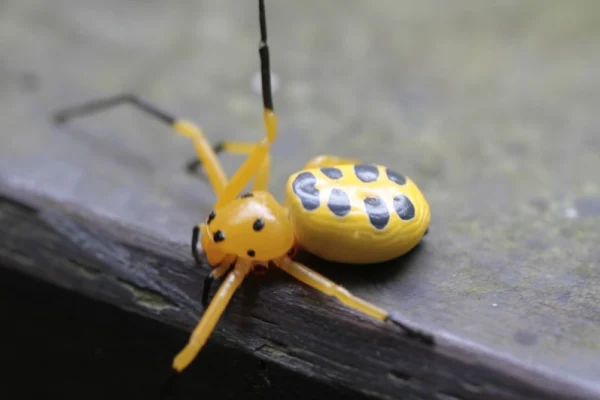
| Scientific name | Platythomisus quadrimaculatus |
| Location | Indonesia, Africa, and Southern Asia |
| Size | Females up to 20mm; males up to 4mm |
| Identification | Bright yellow-orange color with four round, black marks on the cephalothorax and seven large black marks on the opisthosoma |
The 8-spotted crab spider, Platythomisus quadrimaculatus, belongs to the genus of flattened crab spiders from the family Thomisidae. It is so pretty that it practically passes for a plastic toy; it doesn’t even look real.
There are eight huge black spots on its abdomen contrasting with the extremely prominent yellow color of its body.
2. Purcell’s peacock spider- Maratus purcellae
| Scientific name | Maratus purcellae |
| Location | Australia (New South Wales, Australian Capital Territory) |
| Size | About 2.5 mm |
| Identification | The male’s legs are off-white with a layer of white setae, and the dorsum of each pedipalp has a line of bright white scales covering it. |
This species, which barely measures 2.5 mm in length is most likely the tiniest peacock spider yet discovered, and it is not entirely yellow though, and appears with some black contrast.
Maratus is a genus of jumping spiders of the Salticidae family.
As all arachnophiles must already know, peacock spiders are among the most attractive spiders, and this particular type is no exception.
However, these vividly colored iridescent patterns are distinctive to males. Female members of the genus lack this appealing look and have cryptic features.
On their gold-yellow bodies, their eyes appear like sapphire gems. It is a Sensitive, Very Rare/Threatened species.
This species poses no threat to humans and is entirely non-invasive.
3. Seven-Spined Crab Spider- Epicadus heterogaster
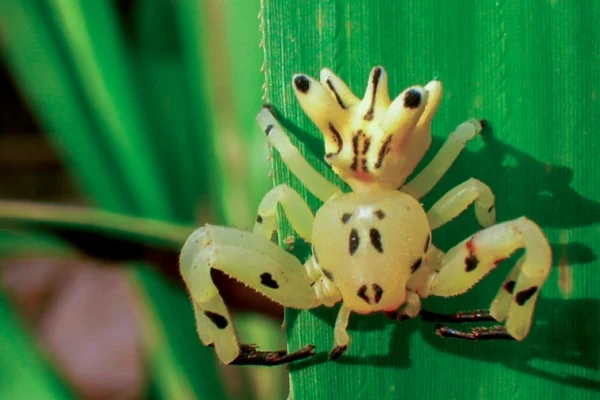
| Scientific name | Epicadus heterogaster |
| Location | Costa Rica, Panama, Colombia, Venezuela, Guyana, Ecuador, Peru, Bolivia, Brazil, Paraguay, Argentina |
| Size | Between 0.29 and 0.60 cm |
| Identification | Their opisthosoma, which has seven opisthosomal projections instead of three or five, has an extra pair of eminences on the anterior border. |
The nickname “seven-spined Crab Spider” is given to Epicadus heterogaster because it refers to the creature’s spine-like abdomen. Which is not really sharp, though.
Practically, Epicadus heterogaster displays a high level of polychromy. While complete yellow is the most popular color, additional hues like pink over white, purple, or a combination of those hues are also recorded.
Such color variations might be due to camouflage at their hunting locations since they don’t appear to follow a geographic trend. Or it’s possible that these spiders, like some other thomisids, can change their color.
4. Golden Silk Orb Weaver Spider- Trichonephila clavipes

| Scientific name | Trichonephila clavipes |
| Location | Native to both continental North and South America |
| Size | Females: 24 mm-40 mm, males: about 6mm |
| Identification | The females of this species are among the largest non-tarantula-like spiders which is the identifying factor. |
Trichonephila clavipes is an orb-weaving spider species that lives in forests and wooded places from the southern United States to Argentina. It also has the common names golden silk orb-weaver, golden silk spider, and banana spider.
As the name would imply, it is a golden and brown spider with fluffy bristles on its legs.
The females of Trichonephila clavipes are among the largest non-tarantula-like spiders in North America, and they are possibly the biggest orb-weavers.
5. 4-Spot Orb-Weaver (Araneus quadratus)
| Scientific name | Araneus quadratus |
| Location | Europe, Central Asia, the Kamchatka Peninsula, and Japan |
| Size | Females may reach 17 mm while males are half of their size |
| Identification | The color of the abdomen can range from deep brown to vivid orange or yellowish-green. The legs are striped. |
The four-spot orb-weaver, Araneus quadratus, is a common orb-weaver that can be found throughout Europe, Central Asia, the Kamchatka Peninsula, and Japan.
Although varied, this species is typically tan-yellow or yellow-green. The spider dwells everywhere there is vegetation to weave an orb web across, including gardens, woodland regions, marshes, and extensive grasslands.
Compared to the webs of other orb-weaver species, this one is smaller and situated closer to the ground.
Females can purposely change their skin tone. It takes roughly three days for the colors to precisely match the surface where they are sitting.
6. European garden spider

| Scientific name | Araneus diadematus |
| Location | Europe (native), North America (introduced) |
| Size | Adult females: 6.5 to 20 mm, while males: 5.5 to 13 mm |
| Identification | Great size difference between its two genders and cruciform white markings makes it easy to identify. |
Araneus diadematus is a spider from the family Araneidae. It is also known as the European garden spider, crowned orb weaver, diadem spider, cross spider, and orangie.
Araneus diadematus spider is an oddly secluded creature that only bites people when trapped or otherwise provoked. It reacts to a disturbance by rapidly vibrating its web until it blurs, which is thought to ward off potential predators.
Indeed, the most intriguing part about these spiders is how strategically they prey.
Firstly, the Orb-weaver spiders have legs designed specifically for weaving orb webs. Secondly, the larger females create webs.
They hang their head down in the center of the web, one claw hooked to a signal line attached to the central orb, waiting for a disruption to signal the approach of prey.
Eventually, the spider may bite its prey before quickly wrapping it in silk and hanging it on the web to be kept for later consumption. The initial bite paralyzes the prey, and the enzymes injected start to liquefy the victim’s internal organs.
7. Australian triangular spider
| Scientific name | Arkys lancearius |
| Location | Australia |
| Size | Females- about 8mm; males-about 5.5mm |
| Identification | Its abdomen is triangular to heart-shaped, with white spots on its bright orange body. |
The family Arkyidae includes the Australian triangular spider, Arkys lancearius.
It is an ambush hunter, typically residing nearby, resting on leaves and ferns or hanging from a few silk strands.
It is undoubtedly a sight in Australia, especially on the East Coast.
Although they can hide in gardens too they are typically found in eucalyptus forests and woodlands.
Its brilliant orange body has white dots on its triangular to heart-shaped abdomen. Its two front pairs of legs have strong spines for catching prey.
The color of its body can range from yellow or orange to red, and the heart-shaped abdomen has light jewel-like markings.
8. Marbled Orb Weaver
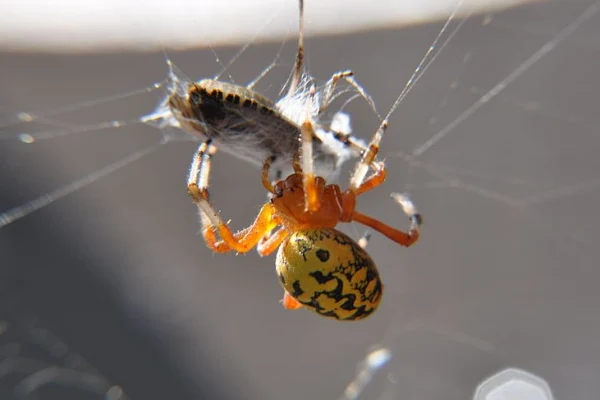
| Scientific name | Araneus marmoreus |
| Location | Holarctic distribution |
| Size | Females: 9.0 to 18.0 mm & males: 5.9 to 8.4 mm |
| Identification | Marbled orb-weavers have an oval-shaped abdomen; this sets them apart from other orb-weaver spiders. |
Araneidae is a family of spiders, and Araneus marmoreus, often known as the marbled orb weaver, is one of its species. Due to the female’s mushroomed abdomen resembling a yellowish pumpkin, people also call them the pumpkin spiders.
Similar to other orb-weavers, they play strategically while pursuing their prey.
In addition to deciduous, Alpine, and coniferous forests, the marbled orb-weavers thrive in meadows, agricultural fields, orchards, along rivers, and in rural and suburban settings.
As polymorphic creatures, these spiders exhibit a vast range of hues and patterns.
9. Bulbous Spiny Orb Weaver
| Scientific name | Actinacantha globulata |
| Location | Indonesia |
| Size | Up to 10 mm |
| Identification | Belongs to the genus Actinacantha, which only has one species |
The Araneidae family of orb weavers includes the Bulbous Spiny Orb Weaver (Actinacantha globulata). This species can reach a maximum length of 10 mm.
The only species of Actinacantha, this orb-weaver spider, is native to Southeast Asia. So far, it is only known to exist in Indonesia.
In contrast to actual yellow spiders, this species has a texture that appears so smooth that it almost seems plastic.
10. Variable Lynx Yellow Spiders- Oxyopes variabilis
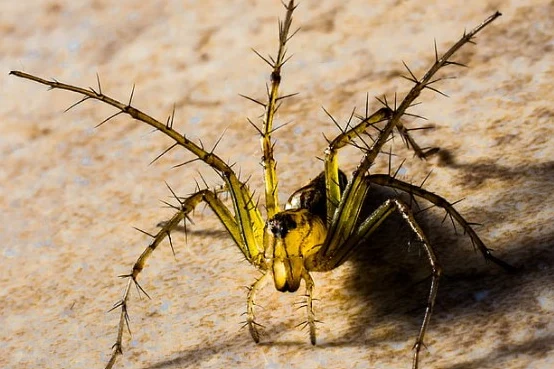
| Scientific name | Oxyopes variabilis |
| Location | Australia |
| Size | 7-12mm |
| Identification | Females of Oxyopes variabilis are distinguished by the epigynum with longer lateral lobes in an inverted V-shaped position and the copulatory ducts with 7 thin coils. |
It is a stunning all-yellow spider that frequently lives and hunts on low plants. Their bodies are a light, patchy yellow tint, and the end of their slightly extended abdomen is tapered.
They are active hunters who hunt through the daytime. Well, that’s a trait they share with their lynx cousin spiders from the genus Oxyopes.
11. Oxyopes Quadrifasciatus
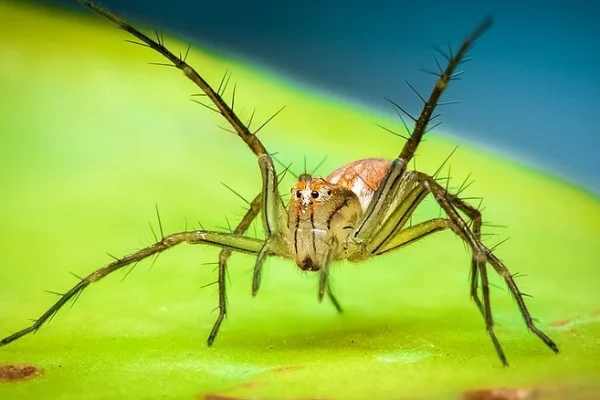
| Scientific name | Oxyopes Quadrifasciatus |
| Location | Australia (Queensland) |
| Size | Leg to leg 20mm |
| Identification | Their eyes have the characteristic pattern of four rows of two. |
Oxyopes Quadrifasciatus, or Lynx Spiders, are beautiful, long-legged, medium-sized yellow spiders.
Instead of creating webs, one of its distinctive behaviors is hunting tiny insects on plants. Although the eyes of lynx spiders are small and grouped in a distinct pattern of four rows of two, they have good eyesight.
They are often active throughout the afternoon, seeking small insects on trees or grasses, typically on the tops of the short plants.
They are colorful creatures with green-yellow, silver, and orange-brown bands running down their slim bodies and long, thin legs with spines.
12. Dubiepeira dubitata
| Scientific name | Dubiepeira dubitata |
| Location | Venezuela to Brazil |
| Identification | Bright yellow abdomen contrasted with its light-to-dark body |
On the list is yet another orb-weaver from South America, the Dubiepeira dubitata. There have only been a few observations of the species, which has not been the subject of extensive research.
Given their vivid yellow color, they deservingly belong on our list of yellow spiders in nature.
Despite not being entirely yellow, their abdomen stands out in contrast to the rest of their light-to-dark brown body.
13. Northern Yellow Sac spider
| Scientific name | Cheiracanthium mildei |
| Location | Europe and North Africa through the Caucasus to Central Asia. |
| Size | An adult reaches the size of 7–10 mm |
| Identification | Typical pale-yellow body with far long front legs. |
The Northern Yellow Sac spider typically occurs in pale yellow or light green. It is also known as the long-legged sac spider.
The front legs are far longer (up to two times the size) and have twin claws on each end, hence the nickname.
Do you know the Northern Yellow Sac spider is the arachnid that stings humans most often? Although the pain is severe, other than skin-level reactions, it has no major negative effects.
14. Yellow Tailed Spider (Female)- Arachnura feredayi
| Scientific name | Arachnura feredayi |
| Location | Australia & New Zealand |
| Size | Females- up to 18mm; males- only about 1mm |
| Identification | The female has an odd appearance with a stretched, lengthy, yellow-brown abdomen that resembles a tail. The male specimen is quite small, with a body length of just 1 mm, and lacks a tail. |
The tailed forest spider, Arachnura feredayi, is native to Australia and New Zealand. On both the North and South Islands of New Zealand, it lives in gardens and forests.
The orb web Arachnura feredayi creates is typically woven close to the ground. By devouring their old webs before constructing a new one, spiders of this species preserve the silk proteins of their webs.
15. Arrowhead Yellow Spiders- Verrucosa arenata
| Scientific name | Verrucosa arenata |
| Location | All across North America |
| Size | Between 7–14 mm |
| Identification | They have an abdomen that is pointy and triangular, shaped like the tip of an arrow. |
This species of orb-weaver spider, Verrucosa arenata, may be found all throughout North America. It is also known as the triangle orb weaver, arrowhead spider, and arrowhead orb weaver.
This is one of the few huge orb-weaver spiders that is reported to sit on its web looking upwards.
It is an interesting habit that each morning/evening, Verrucosa arenata spiders typically create a great, loose web low in trees, which they take down after sunrise.
They often live in open, humid places where they may get direct sunshine in the late summer and early fall.
16. Common Candy-striped spider

| Scientific name | Enoplognatha ovata |
| Location | Europe (native) & North America |
| Size | Up to 6 mm (excluding legs) |
| Identification | They have translucent legs, and a globular abdomen which is extremely variable in colour and pattern |
The common candy-striped spider, Enoplognatha ovata, belongs to the Theridiidae family. The term “ovatus” in Latin, which means “egg-shaped,” is the basis of their scientific name. Despite its small frame, this predator can take down insects that are several times its size.
This spider has a globular abdomen, transparent legs, characteristic rows of dark spots, and one or two wide red stripes arranged in a V-shape. Plus, its base color is typically yellow, white, cream, or green.
17. Araniella opisthographa
| Scientific name | Araniella opisthographa |
| Location | Widespread in western and central Europe and southern England |
| Size | 3.5-4mm in males; 4-6mm in females |
| Identification | In males, the cephalothorax is typically yellow to reddish brown with broad, black border bands. The abdomen is bright yellowish green on top, with five pairs of black lateral dots and four little black depressions in the middle. |
Araniella opisthographa is a species of orb weaver in the spider family Araneidae.
The spider is found in a wide variety of situations, but most commonly on trees (particularly oaks) and bushes in woodland, scrub, and hedgerows, as well as on nearby low vegetation. They are a pale yellowish green in color.
18. Slater Spider (Dysdera crocata)
| Scientific name | Dysdera crocata |
| Location | Mediterranean region (native), introduced to South Africa, Australia, Chile, and Asia. Also found in North America. |
| Size | 9-15 mm |
| Identification | The front half (cephalothorax) and the appendages are yellowish-orange. The abdomen is grayish-yellow to pale in color. |
Other frequent names for the woodlouse spider include slater spider, sowbug killer, pillbug hunter, and woodlouse hunter, all variations of its prey.
These are the yellow-tan spiders that mostly eat woodlice. Dysdera crocata is the only one in the family known to feed on other spider species.
They can eat other common ground-dwelling invertebrates, including silverfish, earwigs, millipedes, and small burying beetles because they can emit certain enzymes that counteract the chemical defenses of potential meals.
19. Micrathena schreibersi
| Scientific name | Micrathena schreibersi |
| Location | America |
| Size | 2–30mm |
| Identification | Its unique appearance |
The Micrathena schreibersi species, also called the Amazon thorn spider, belongs to the genus Micrathena and the family Araneidae. The Americas are the home of this species.
This genus is well-liked for having very long spines that probably serve as predator defenses.
Micrathena schreibersi species range in size from 2 to 30mm and have a wide range of colors and forms. Though it is not entirely yellow and quite vivid in appearance, it still deserves a spot on our list to credit the dominance of yellow.
20. Green Huntsman spider
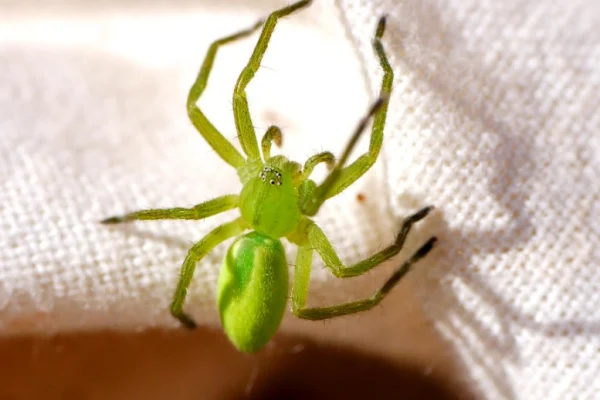
| Scientific name | Micrommata virescens |
| Location | Palearctic distribution. |
| Size | Females: 12–16 mm; males: 7-10mm |
| Identification | The bright green cephalothorax and lengthy legs of the females are contrasted with a deeper green median stripe on the lighter green abdomen. |
In Europe, one might frequently encounter the Green Huntsman spider. This species is distinguished by its brilliant green hue.
Adolescent Green Huntsman spiders typically have an all-yellow coloring.
Also, some of this species’ morphs can be green with a yellow undertone.
Micrommata virescens spider uses its color as a kind of concealment. Hence it is primarily influenced by its surroundings, much like some other arachnids.
21. Banded Garden Spider
| Scientific name | Argiope trifasciata |
| Location | Worldwide distribution but native to North and South America |
| Size | Up to 2.5 cm |
| Identification | Generally small, with a sharper tail end. Additionally, the abdomen is patterned with broader, spotted black lines and numerous tiny, transverse lines of silver and yellow. The head, or cephalothorax, is tiny and hairy in silver. |
Banded Garden Spider is the popular name for this beautiful and unusual-looking creature. Originally from North and South America, Argiope trifasciata is a species now distributed worldwide.
This spider, recognized for its lengthy legs, is an excellent insect predator. They appear in October when the weather begins to cool off, as they enjoy colder climates.
The adult females of this species are between 15 and 25 millimeters long, making them somewhat smaller than yellow garden spiders. There are silvery hairs all around the carapace. In contrast, the males have mainly white abdomens and measure 4 to 5 millimeters in length.
22. Barn Spider
| Scientific name | Araneus cavaticus |
| Location | North America, specifically in southern parts of Canada and the northeastern United States |
| Size | Around 20 mm |
| Identification | The bright green cephalothorax and lengthy legs of the females are contrasted with a deeper green median stripe on the lighter green abdomen. |
Native to North America, the barn spider is a common orb-weaver spider. They are typically brownish-yellow in color, and they are around 3/4 of an inch in length. Their common name comes from the fact that they frequently weave their webs inside wooden human buildings.
The barn spider, like other spiders, has extremely poor vision. Rather than using its other senses, including sight or smell, it uses vibrations to detect its prey.
Barn spiders are nocturnal creatures that hunt at night for food. They rebuild their web in the evening after retracting it during the day.
23. Giant Golden Orb Weaver
| Scientific name | Nephila pilipes |
| Location | East and Southeast Asia |
| Size | Females: 30–50 mm; males: 5–6 mm |
| Identification | The abdomen is roughly 30 mm length, with yellow stripes and a predominantly dark yellow-brown shading. With a rich covering of hair, the tergum is often dark or black. |
Nephila pilipes is a golden orb-web spider. It is found throughout Oceania and all the countries in East and Southeast Asia. Primary and secondary forests, as well as gardens, are the preferable habitats to find it. Additionally, this species favors low light levels and little precipitation.
People fear this spider because of the more severe reported side effects of a bite, like stiffness and muscle spasms. These bites are uncommon, though.
24. Grass Cross Spider (St Andrews Cross Spider)
| Scientific name | Argiope catenulata |
| Location | India, Philippines, Papua New Guinea, and Australia |
| Size | Female = 18 mm; male = 5 mm |
| Identification | Elongated abdomen that is oval and pointed distally. And thick reddish bands lie parallel throughout the dorsum |
Argiope catenulata, commonly called the grass cross spider, is a species of orb-weaver spider with a range extending from India to the Philippines and Papua New Guinea. It constructs a web with a zigzag stabilimentum, just like other species in its genus.
It’s a colorful spider where the female has black eye margins and a yellow cephalothorax. Additionally, its rectangular abdomen is dorsally patterned in black and silvery-whitish colors.
Which Yellow Spiders Are VENOMOUS?
The two species with the worst bite reactions out of the 24 we have covered are the giant golden orb-weaver and the yellow sac spider. And their toxic venom is the cause. Even if there might not be any fatalities, they will undoubtedly induce discomfort, irritability, and mild swelling.
An anaphylactic shock reaction may occur after a yellow sac spider bite. Flesh rotting is an uncommon consequence that can happen after being bitten by one of these spiders. The venom of yellow sac spiders contains cytotoxin, which can cause the bite wound to become necrotic. You would better use caution around them.
Moreover, while most spiders use venom as a defense mechanism, very few side effects last for an extended period of time. Additionally, because they are reclusive animals, it is best to leave them alone in their natural environment; otherwise, they may bite if they sense a danger.
Conclusion
In conclusion, the realm of yellow spiders offers a captivating glimpse into diverse species, each displaying unique traits and vital ecological roles.
Studying and preserving these arachnids and their habitats is crucial for appreciating nature’s intricacies and maintaining a harmonious ecosystem.
Frequently Asked Questions
Q1. Is a yellow spider poisonous?
Ans. A yellow sac spider bite can, under extreme circumstances, result in anaphylactic shock. However, the majority of their bites are harmless to humans. Yet, until we are aware of that particular species, we are unable to determine if yellow spiders are poisonous or not.
Q2. Is a yellow garden spider harmless?
Ans. Due to their size and vivid colors, yellow garden spiders are feared by a lot of individuals. These pests, however, won’t bite unless they are contacted or hurt. A yellow garden spider’s bite hurts like a bee sting. These arachnids are generally harmless.
Q3. Are yellow spiders poisonous in the UK?
Ans.Known for its vivid yellow hue, yellow sac spiders are a popular species of spider found in the United Kingdom. Gardens and other outdoor spaces are common places to find them. Although people are usually not in danger from their bites, they can cause discomfort, swelling, and itching.
Q4. What is the name of a yellow spider?
Ans. Argiope aurantia Lucas is a huge orb-weaving spider, most commonly known as the yellow garden spider. However, there are many types of yellow spiders.
Q5. What happens if a yellow spider bites you?
Ans. The bite is not painful at first, and symptoms start to appear two to eight hours after the bite. It feels like a mosquito sting at first, then gets worse and swollen.
Q6. Why do I have yellow spiders in my house?
Ans. A yellow spider may enter a house through an open door or by following prey insect infestations that may stray inside.
Also Read

Anjali Prasad, a B. Pharm. graduate who works as a content writer for HowItSee, is based in Delhi. Except for her, not many people take the typical road from healthcare to writing. Her love of writing stemmed from her involvement in the college literature society and her early journaling at the age of 7. Hence, the love of learning and the spirit of exploration are what drew her to this career. You can find her on common social media like Instagram.

